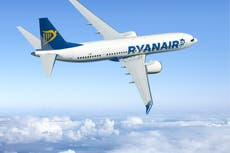Indonesia missing plane: Dozens feared dead after Boeing 737 drops 10,000ft into the sea
Investigators will consider a wide range of possible causes, including mechanical failure, terrorism or an encounter with a storm cell
Shortly before 6am, Indonesian navy divers will resume their search off the north coast of Java for a Boeing 737 that crashed into the sea shortly after take off from Jakarta on Saturday afternoon.
Sixty-two people are missing.
Sriwijaya Air flight SJ182 departed from Soekarno Hatta International Airport at 2.36pm local time (7.36am GMT). The routine domestic flight covering the 452 miles to Pontianak on the island of Borneo is scheduled to take 95 minutes.
The flight-tracking website FlightRadar24 reported that the plane took off to the southwest and initially climbed normally, turning to head northeast to its destination.
The 26-year-old 737 flew a short distance north of the airport and out over the Java Sea before contact was lost.
The twin-jet reached its highest altitude, 10,900 feet, four minutes after take off. But within 21 seconds it had dropped to just 250 feet above sea level. That equates to a vertical speed of over 25,000 feet per minute (340mph).
Local fishermen told CNN that they heard an explosion and were hit by a high wave around the time the plane went missing.
Hendrik Mulyadi told the broadcaster: ”I heard very loud explosion. I thought it was a bomb or a big thunder. We then saw the big wave, about 2 metres high, hitting our boat.”
The Indonesian navy has sent five ships as well as divers to an area about 12 miles north of the shore.
Jefferson Irwin Jauwena, the chief executive of Sriwijaya Air, said: “We hope that your prayers will help the search process to run well and smoothly.”
The flight’s departure was delayed by around 40 minutes because of poor weather, with storm clouds over the airport. At the time the plane took off rain was falling, with a low cloud base.
The recovery operation will seek to locate the plane’s “black boxes” – the cockpit voice recorder and flight data recorder – as quickly as possible.
They should provide information on the control commands on the flight deck, and conversations between the captain and first officer.
Investigators will consider a wide range of possible causes, including mechanical failure, terrorism or an encounter with a storm cell – an air mass with violent winds.
They will also look at the experience of the pilots, including the amount of flying they have done during the coronavirus pandemic, and the recent operations of the plane involved.
Some aviation safety experts have expressed concerns about the return to service of aircraft and crews after Covid restrictions.
The search area is close to where Lion Air flight 610 came down on 29 October 2018. All 189 passengers and crew died aboard the Boeing 737 Max. It was the first of two tragedies that led to the 20-month grounding of the Max.
The latest version of the 737 re-entered service in December 2020 after comprehensive changes to a software system that, when activated by a faulty sensor, triggered both crashes.
The aircraft manufacturer tweeted: “We are aware of media reports from Jakarta regarding Sriwijaya Air flight SJ182.
“Our thoughts are with the crew, passengers, and their families. We are in contact with our airline customer and stand ready to support them during this difficult time.”
The Sriwijaya Air flight involved a “Classic” 737, two generations older than the Boeing 737 Max. It was delivered in May 1994 to Continental Airlines of the US, and in 2012 joined the Sriwijaya Air fleet.
The carrier is a relatively small budget airline. It started flying in 2003 and has never suffered a fatal crash.
The report into the Lion Air tragedy blamed software installed by Boeing on the latest version of the 737, which was triggered by a faulty sensor and forced the nose down despite the pilots’ efforts to save the aircraft. But it also criticised Lion Air's maintenance team.
All Indonesian carriers were placed on the EU Air Safety List in 2007 due to “unaddressed safety concerns”. The blacklist bans or restricts operations within the European Union by airlines that are believed not to meet international safety standards.
The prohibition was not finally lifted until June 2018, four months before the Lion Air Boeing 737 Max crash.



Join our commenting forum
Join thought-provoking conversations, follow other Independent readers and see their replies
Comments